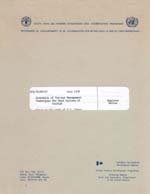
Economics of Various Management Techniques for Pond Culture of Finfish Regional Review
 |
Work Plan Implementation (Working Paper) SCS/7S/WP/37 SOUTH CHINA SEA FISHERIES DEVELOPMENT AND COORDINATING PROGRAMME Economics of Various Management Techniques for Pond Culture of Finfish Regional Review |
NOTICE OF ERRATA
This is a reissue of SCS/76/WP/37. In the first copy of this document sent to you it was noted that there were omissions on pages 2, 3, 4 and an error on page 12. This has now been corrected and the pages adjusted.
Please return or discard the first copy you received and replace it with this one. We apologize for the inconvenience.
| South China Sea Fisheries Development and Coordinating Programme | |
| Manila, Philippines | |
| 29 October 1976 |
PREPARATION OF THIS REPORT
This document was prepared by the consultant in cooperation with the aquaculture staff of the South China Sea Programme during the period from 12 October to 3 December 1975. H. R. Rabanal, Senior Aquaculture Officer of the Programme, assembled available material, arranged the field surveys and supervised the writing of the paper. It was reviewed by the Programme personnel and further technical editing was made by the FAO Headquarters Staff. As it was solicited as a contribution to the FAO Technical Conference on Aquaculture (Kyoto, Japan, 26 May - 2 June 1976) it will appear in the Proceedings of that Conference.
ECONOMICS OF VARIOUS MANAGEMENT TECHNIQUES
FOR POND CULTURE OF FINFISH
Based on the work of
Y. C. Shang*
Consultant
Project Document Identification
Work Plan Activity: 4(a) and c(ii)
4 Aquaculture
Determination of particular aquaculture systems most likely to be profitable
Examination of factors affecting productivity and profitability of existing and future aquaculture operations
Examine costs and benefits of different sizes of farm, with special reference to supplies and uses of materials and labour.
On a worldwide basis, pond culture of finfish produces about 75 percent of the production in weight and utilizes about 90 percent of the area devo ed to aquaculture. It is estimated that it has stimulated a capital exchange investment of about US$3 500 million. The potential for increasing aquaculture production through pond culture of finfish is high.
An analysis is made of the economics of finfish pond culture in order to: (i) establish improved management practices that will make the industry more profitable; (ii) guide the formulation of policies and programmes which affect development of the aquaculture industry.
The species considered in this study are: milkfish, common carp, Chinese carp, Indian major carps, catfishes (channel, Clarias, pangasid), tilapia, grey mullet, eel and rainbow trout.
The profitability of the use of monoculture versus polyculture and the use of extensive versus intensive techniques are explored with respect to a number of these species.
Seed, fertilizer, feed, labour, marketing and interest constitute the major cost items of pond culture operations, and research on reduction of these costs is of high priority.
SOUTH CHINA SEA FISHERIES DEVELOPMENT AND COORDINATING PROGRAMME
Manila, Philippines
July 1976
Hyperlinks to non-FAO Internet sites do not imply any official endorsement of or responsibility for the opinions, ideas, data or products presented at these locations, or guarantee the validity of the information provided. The sole purpose of links to non-FAO sites is to indicate further information available on related topics.
This electronic document has been scanned using optical character recognition (OCR) software. FAO declines all responsibility for any discrepancies that may exist between the present document and its original printed version.
(ii) Summary of recommendations
2. ECONOMIC ANALYSIS BY SPECIES, TECHNIQUES AND SYSTEMS
3.2 Reduction in Cost of Production and Marketing